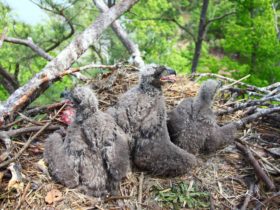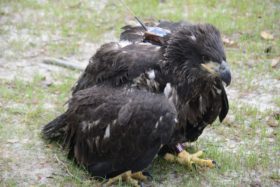Have HE and HK left?
Dependent / Independent
July 24, 2009No avian pox
July 27, 2009
 Azalea (HH) was at the nest and camera tree all day today all by herself (photos). One of the adults brought in a fish about 8:00am and again about 12:35pm and HE did not show up as she has been doing. HK has not been seen at the nest since last Monday, July 20 and not seen around the dump area for a few days. I searched about this morning including a boat tour which gives a good view of the dump and the area around the airport which you pass going out and returning and no sign of either HE or HK. Several photographers were there today (Duane, Dana, Big John, Bill, Frank, Holly) and none saw them either. So, have HE and HK left NBG? Hmmm! Let’s give them a couple more days before we make that pronoucement. I plan to check again tomorrow. Anyone for a boat tour?
Azalea (HH) was at the nest and camera tree all day today all by herself (photos). One of the adults brought in a fish about 8:00am and again about 12:35pm and HE did not show up as she has been doing. HK has not been seen at the nest since last Monday, July 20 and not seen around the dump area for a few days. I searched about this morning including a boat tour which gives a good view of the dump and the area around the airport which you pass going out and returning and no sign of either HE or HK. Several photographers were there today (Duane, Dana, Big John, Bill, Frank, Holly) and none saw them either. So, have HE and HK left NBG? Hmmm! Let’s give them a couple more days before we make that pronoucement. I plan to check again tomorrow. Anyone for a boat tour?




5 Comments
Another question from a “first-seasoner”….when the banded young eagles leave (HK and HE), will NBG hear/learn anyhing about them again? I’m grateful that, for the next few years anyway, we will at least continue to know what Azalea’s up to.
Claudia – The purpose of the bright purple bands (HE, HH, HK) is to make them easier to identify and read at a distance. The hope is that they will be seen again here or at other locations that they may visit. The purple band identifies the eagle as being from the Chesapeake Bay region. Last year we believe one of the 2007 NBG eagles was seen in nearby Portsmouth, and the USGS band was visible but the number could not be read. This season I recovered two Osprey that I banded as nestlings. I banded one 10 years ago at False Cape State Park. Unfortunately it was dead on its nest with two chicks in the nest. I removed the chicks who were too young to fly and will release them later this week. Another Osprey that I banded in Portsmouth 8 years ago was found tangled in fishing line again (it was also tangled in fishing line as a nestling). It recovered at a rehabilators and I released it two weeks ago. In both these incidents we learned that these Osprey had returned to their natal territory to breed. Without them being banded we would not have known where they had been born. It usually takes years for banding to pay dividends like this.
I did make it back to NBG today and got part of the answer to the question “Have HE and HK left?” HE was at “the dump” with the adult female. Later Azalea (HH) was also seen there and back at the nest tree. As for HK, he has not been seen since Monday July 20. In 2007, the three young eagles visited the Little Creek Reservior which is only about one mile from NBG in Virginia Beach. I checked there yesterday and did not find him, but can’t see every where along that lake. Appears he may have left the area.
Reese
on Monday July 27 I saw a juvenile eagle standing at the end of runway 23 at Norfolk Airport at about 0705. It only looked up as we were taking the runway.
Jim
Jim – Saw your comment and photo on both forum sites. Both HE and HH were at the dump site yesterday morning, so was probably one of them.